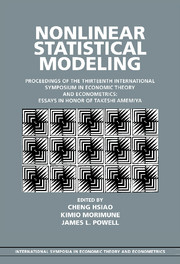 Nonlinear Statistical Modeling
Nonlinear Statistical Modeling Book contents
- Frontmatter
- Contents
- Series editor's introduction
- Editors' introduction
- Contributors
- 1 Local instrumental variables
- 2 Empirically relevant power comparisons for limited-dependent-variable models
- 3 Simulation estimation of polychotomous-choice sample selection models
- 4 A new approach to the attrition problem in longitudinal studies
- 5 Semiparametric estimation for left-censored duration models
- 6 Semiparametric estimation of censored selection models
- 7 Studentization in Edgeworth expansions for estimates of semiparametric index models
- 8 Nonparametric identification under response-based sampling
- 9 On selecting regression variables to maximize their significance
- 10 Using information on the moments of disturbances to increase the efficiency of estimation
- 11 Minimal conditions for weak convergence of the sample standardized spectral distribution function
- 12 Unit root tests for time series with a structural break when the break point is known
- 13 Power comparisons of the discontinuous trend unit root tests
- 14 On the simultaneous switching autoregressive model
- 15 Some econometrics of scarring
- 16 A censored switching regression approach to evaluating the effect of sunk costs and firm-level disequilibrium on export performance
- Curriculum vitae of Takeshi Amemiya
- Index
3 - Simulation estimation of polychotomous-choice sample selection models
Published online by Cambridge University Press: 05 June 2012
- Frontmatter
- Contents
- Series editor's introduction
- Editors' introduction
- Contributors
- 1 Local instrumental variables
- 2 Empirically relevant power comparisons for limited-dependent-variable models
- 3 Simulation estimation of polychotomous-choice sample selection models
- 4 A new approach to the attrition problem in longitudinal studies
- 5 Semiparametric estimation for left-censored duration models
- 6 Semiparametric estimation of censored selection models
- 7 Studentization in Edgeworth expansions for estimates of semiparametric index models
- 8 Nonparametric identification under response-based sampling
- 9 On selecting regression variables to maximize their significance
- 10 Using information on the moments of disturbances to increase the efficiency of estimation
- 11 Minimal conditions for weak convergence of the sample standardized spectral distribution function
- 12 Unit root tests for time series with a structural break when the break point is known
- 13 Power comparisons of the discontinuous trend unit root tests
- 14 On the simultaneous switching autoregressive model
- 15 Some econometrics of scarring
- 16 A censored switching regression approach to evaluating the effect of sunk costs and firm-level disequilibrium on export performance
- Curriculum vitae of Takeshi Amemiya
- Index
Summary
Introduction
This chapter considers the estimation of sample selection (SEL) models with polychotomous choices or multiple selection criteria.The focus is on the estimation of models which require estimation via simulation techniques. An example of such models is a model with multivariate normal disturbances. SEL models with polychotomous choices have been considered in Dubin and McFadden (1984), Lee (1983), and others, under extreme-value distributions. Schmertmann (1994) discussed limitations of these model specifications. In some empirical studies, in order to achieve simplicity, researchers imposed restrictive and unrealistic assumptions such as independence across disturbances of equations. Such practices resulted in controversies and debates (e.g., Duan et al. 1984, Hay and Olsen 1984). In many circumstances with complex selection criteria, multivariate normal disturbances may be the preferred specification (Amemiya 1974, Hausman and Wise 1978). With the development of simulation estimation methods, complex models can, in principle, be estimated (McFadden 1989, Pakes and Pollard 1989). Methods of simulated moments (MSM), simulated pseudolikelihood (SPL), and simulated maximum likelihood (SML) have been proposed in the literature (see McFadden 1989, Pakes and Pollard 1989, Lee 1992, Gourieroux and Monfort 1993, and Borsch–Supan and Hajivassiliou 1993). Parameter estimates may, however, be sensitive to simulators used (McFadden and Ruud 1994). The GHK simulator introduced by Geweke (1991), Borsch-Supan and Hajivassiliou (1993), and Keane (1994) provides an adequate probability simulator for the multinomial probit model. Monte Carlo results on comparing various simulation methods and simulators have mostly focused on discrete choice (DC) models (Hajivassiliou, McFadden, and Ruud 1996, Borsch-Supan and Hajivassiliou 1993, Geweke, Keane, andRunkle 1994, 1997).
- Type
- Chapter
- Information
- Nonlinear Statistical ModelingProceedings of the Thirteenth International Symposium in Economic Theory and Econometrics: Essays in Honor of Takeshi Amemiya, pp. 71 - 118Publisher: Cambridge University PressPrint publication year: 2001


